Oven beer in central Russia
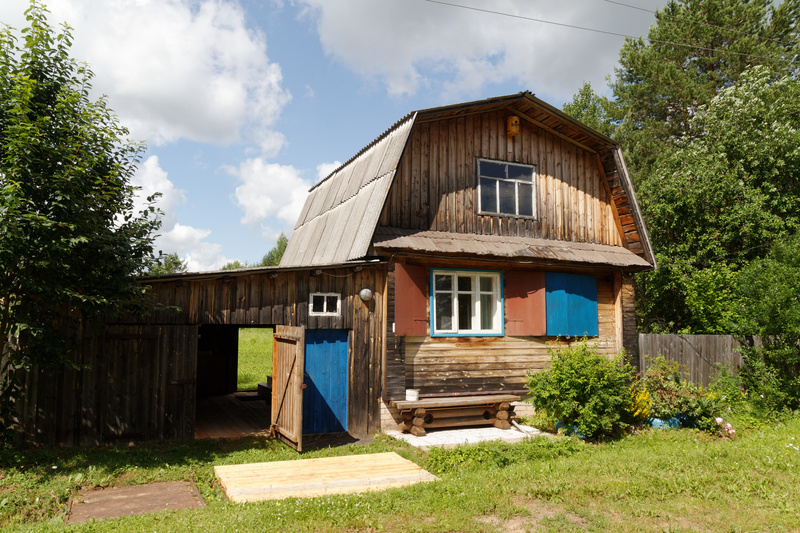
Dmitriy's dacha in Shitovo |
Dmitriy stopped the car outside his dacha (summer house) in the tiny village of Shitovo, and jumped out. He turned to us, beaming with arms outstretched, and said "Welcome to Shitovo." Then he ran off to open the doors to the dacha, and disappeared inside. We'd come to Shitovo, outside Kirov in central Russia to learn how Dmitriy Zhezlov brews his farmhouse ale. This was the second stop on our Russian farmhouse ale expedition. We'd travelled west from our previous base in Perm, and were now "only" 800 kilometers east of Moscow.
In the 1990s Dmitriy lived in the village of Vsekhsvyatskoye not far from Shitovo, and learned to brew from an old man there. The village is famous locally for hop growing, and for traditional brewing. It's well off the main roads, which may be part of the reason people still brew there.
Today, Dmitriy is a modern craft beer enthusiast, and one of the organizers of the Vyatskiy Beer Club in nearby Kirov. So he's well familiar with modern craft beer, and in fact has his own beer blog, which is how I found him (and the brewers in Kudymkar). While enjoying modern craft beer he's continued brewing the traditional farmhouse ale.
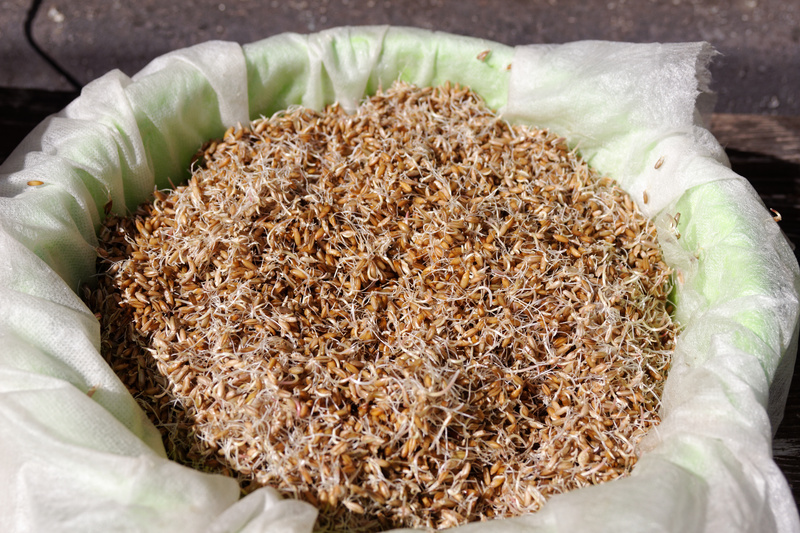
Dmitriy's rye malts |
Dmitriy prefers to brew outside, so once we'd installed ourselves in the dacha he set up his brewing gear outside. He makes his own malts from rye, which he buys in a health food shop. He malts for every batch of beer, so he'd started preparing before we arrived by soaking and sprouting the malts. He set out the malts, with the rootlets and the white shoots still on the malts, and got ready to grind them while I was quizzing him on how he made malts.
He soaks the rye grain for 6 hours, then wraps it up in a bag so it will sprout. It should sprout for three days, until the shoots are about 7-8mm. Because he was busy this time the malts ended up sprouting for too long, but he said it was not really a problem.
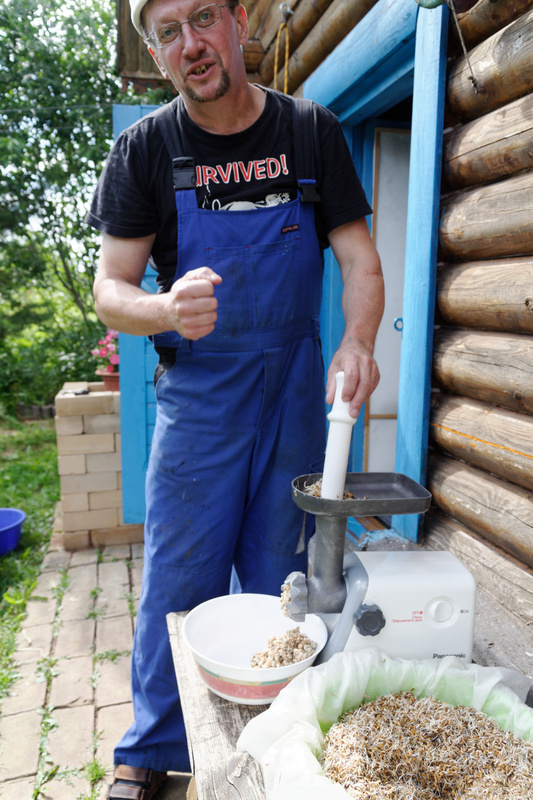
Dmitriy grinding malts |
"So," I asked, "how do you dry the malts?"
Dmitriy: "I don't dry them."
Me: "You don't dry them?"
Dmitriy: "No, I don't dry them." An impish smile flashed over his face.
Silence, only broken by the whirring of Dmitriy's meat grinder milling the malts, while I pondered this.
How could he not dry the malts? I'd never heard of such a thing. Stunned, I started listing in my mind the reasons why you need to dry the malts. One reason is so it won't grow mouldy in storage, but Dmitriy malts for each brew, so that's not a problem for him. Another reason is so you can grind it. But Dmitriy's using a modern meat grinder, so he can easily grind wet malts. And this is rye malts, so it will have colour and flavour even without being dried hot.
So, however weird it sounded, it actually made sense for Dmitriy not to dry the malts. He doesn't need to. Of course, this is an innovation Dmitriy has introduced, because in the old days people didn't have electric meat grinders. Before I was able to ask how they dried the malts in the old days Dmitriy had finished grinding, and rushed off to do something else.
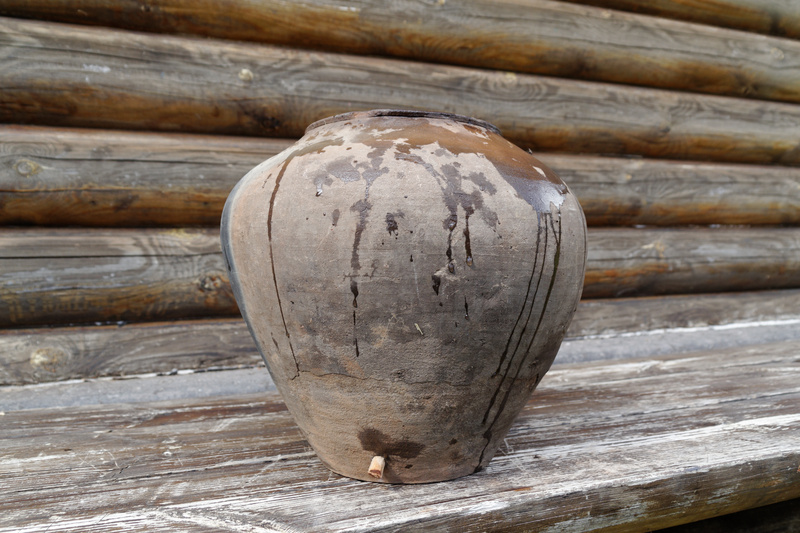
The korchaga |
Once the malts had been ground Dmitriy brought out the korchaga, a ceramic vessel that's really the key to Dmitriy's beer, since it is both the mash tun and the lauter tun. The korchaga is heated in the oven, and then the wort is lautered directly out of it through a small hole near the bottom, which is closed with a wooden plug. To make the mash filter Dmitriy soaked rye straw in water to soften it, and then covered the bottom with carefully cut lengths of straw. The straw has to go above the hole, and the higher layers need to be longer.
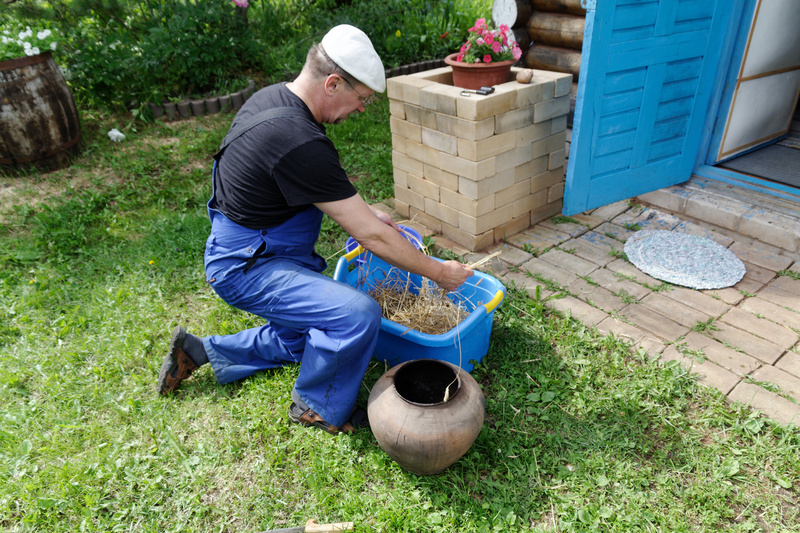
Dmitriy cutting the straw |
Because the korchaga is heated in the oven, the size of the oven limits the size of the korchaga, which again sets the batch size. Dmitriy makes 15 liters of beer per batch, but traditionally people in this area would make 20-25 liters. Compared to most farmhouse brewers this is almost nothing, but the reason is the oven. The way the oven limits the batch size is a challenge for oven brewers everywhere, even commercial ones.
Once the straw has been laid the wooden plug is inserted and Dmitriy pours in the malts. The plug is now covered in clay, to make sure it doesn't dry out, shrink, and fall out during the mashing, because if that happens there will be no beer.

Dmitriy inserting the korchaga in the oven |
Dmitriy started the fire in the pyechka, the great Russian oven, to heat it up for the mashing. The fire took two-three hours to burn out and heat up the oven sufficiently. Then cold water was poured onto the malts in the korchaga, so much that there were several centimeters of water above the top of the malt layer, and the korchaga was inserted among the still glowing embers in the oven. Dmitriy thinks the temperature must have been 150-180C.
So in this case the mashing really happens inside the oven, which is exactly what I'd been hoping to find. It's also interesting to note how simple brewing this way is compared to most farmhouse brewing. This must have been a major simplification compared to brewing with hot stones.

The korchaga inside the oven |
Knowing what the mash temperatures are is obviously a bit of a challenge, but we took the korchaga out after one hour and measured. Then the mash temperature was 80C, so basically the contents had gone through something not too far from a normal mash in that hour. The korchaga was put in the oven in the afternoon, and left until the next morning, around 15 hours. When it was taken out the temperature in the mash was 63C.
After an hour the malts had swelled up, and the surface now looked quite dry. Some water had run over the edge of the korchaga. Not, I think, because it had boiled, but simply because of the swelling.
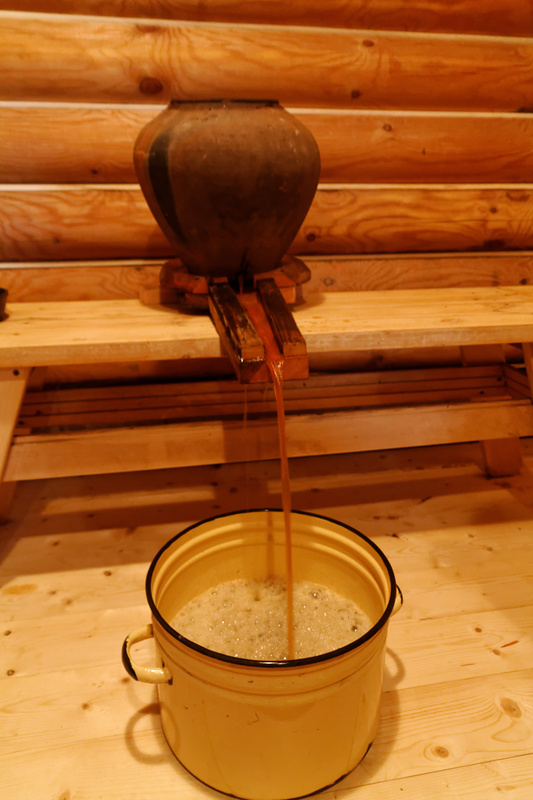
Lautering |
Dmitriy was now ready to run off the wort, which he did in the banya (Russian sauna). The korchaga was placed on a bench, on top of an odd wooden funnel that leads the wort out from the korchaga so that it can run down into the enameled metal kettle below. Usually the wort runs off very slowly, but in this case when Dmitriy removed the plug it all ran out in 30 minutes. Usually it takes 2-3 hours.
Dmitriy was scratching his head and not at all sure why this happened. "This time, I made a perfect filter because I demonstrated to you. So the wort ran off fast," he joked. He boiled water in a water cooker, then poured on an additional two liters for sparging. Afterwards we measured the OG to 1.030. Dmitriy doesn't measure, but he tasted that this wort wasn't nearly sweet enough. "Today is fast version, and light version," he joked.
I was about to ask why it didn't work out as expected when Dmitriy ran off to do something else. I managed to corner him later, and learned that usually he brews with all wet malts, but this time he used 50% dry and 50% wet malts, and that might be the reason. But he wasn't sure.
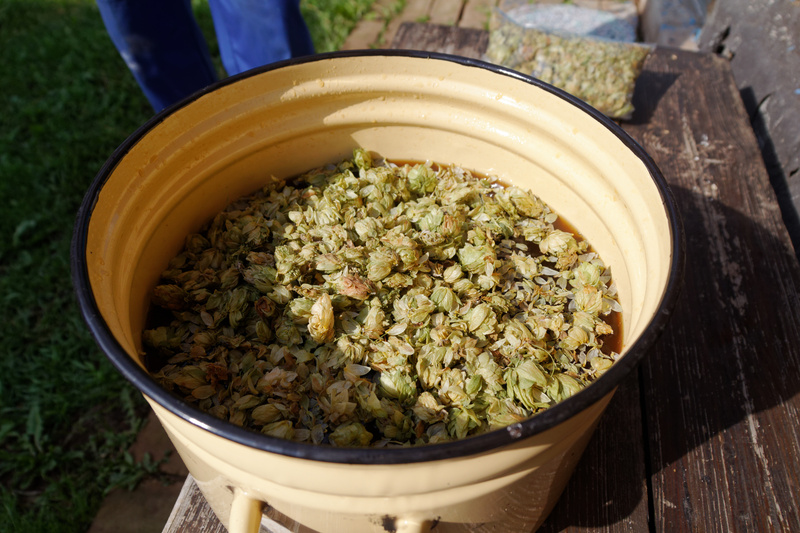
Hops in the wort |
Now that the wort had been run off, Dmitriy dropped hop cones into it. These are hops he collects wild. He's planted the Russian hop variety Serebryanka, but that was in spring, so it wasn't mature yet. Serebryanka, by the way, was one of the grandparents of the American Cascade hop, and thus in a way of the whole craft brewing revolution.
But now it was time to boil the wort. In the old days this would be done in the oven, by starting a fire in the second fireplace, underneath the cooking surface inside the oven. But Dmitriy has a metal stove of sorts that he sets outside, and with the metal pot on top. The wort is boiled for about an hour. At one point it threatened to boil over, so Dmitriy reduced the heat by pouring a glass of water on the fire.
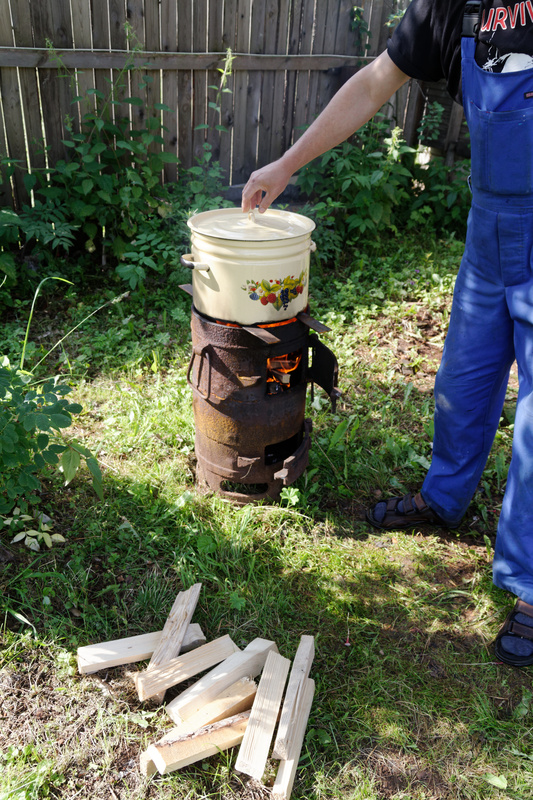
Boiling the wort |
Once it was boiled, the wort was cooled. Since his batch is so small he could just place the entire pot in a cold water bath and cool it that way. I asked Dmitriy what temperature he pitches the yeast at, but he didn't know in degrees. "Like the bathwater of a small child," he said. He checked the temperature the same way you'd do for a baby's bathwater, too: by dipping his elbow in it. Once he was satisfied I checked with my thermometer: 37C.
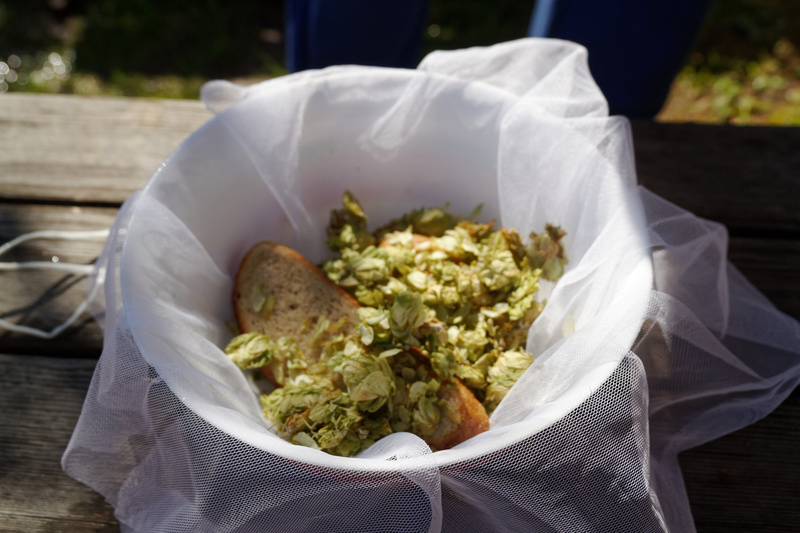
Bread soaked with yeast and hops |
The yeast was a French baking yeast from the shop, but the way he pitched it was definitely unusual. He took an enamelled bowl, then covered it with a piece of gauze. Then he laid two slices of bread on top, poured the yeast starter on the bread, turned it, then poured on some more. He added a stone and a handful of hops, then rubbed the bread into the remaining yeast slurry on the bottom. He looked at me, saying "I don't understand why this method. I could just ..." He mimed pitching the yeast into the wort. But this was the traditional way to do it, so he stuck to that.
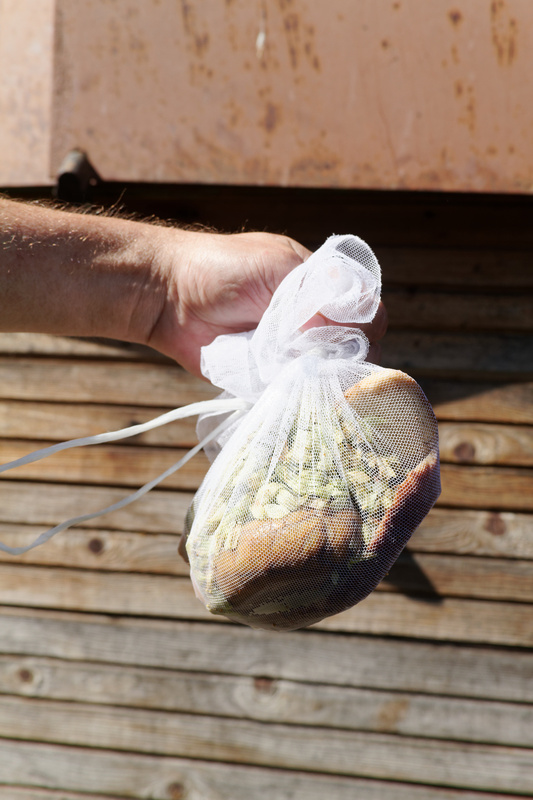
The yeast bag |
Once the wort was cooled he dropped the bag into it. The beer ferments for 7-10 days, but the bag is removed after two days.
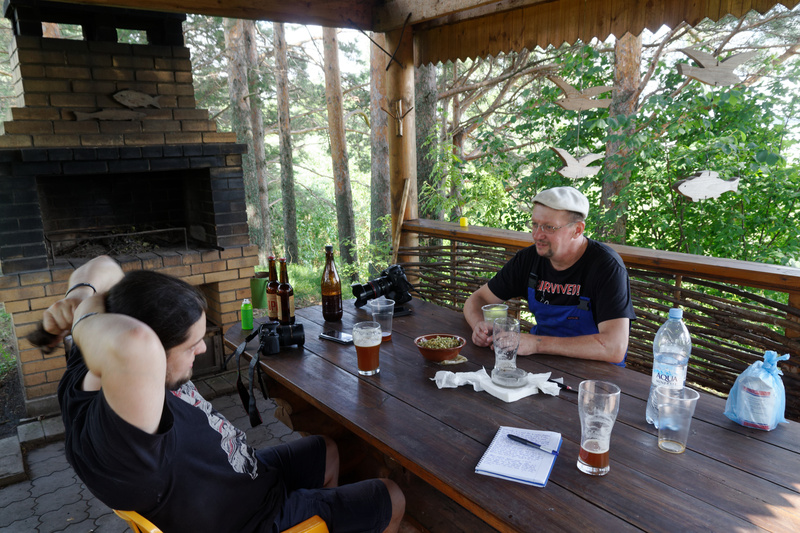
Sasha and Dmitriy in the pavilion |
Earlier, while the oven had been heating up, Dmitriy had proposed that we should take some beers and go to his pavilion by the lake. The pavilion has some simple benches, a table, and a big brick fireplace, with a view out over the lake.
Dmitriy gestured for us to sit, and got ready to serve us beer. Smiling and gesturing, he ended his invitation with what I was to discover was a favourite phrase of his: "With no ceremony." I took it to mean that we should consider ourselves to be among friends and not stand on formalities. His delight in being our host was so obvious that despite having met him for the first time a few hours before we relaxed and did indeed forget about the formalities.
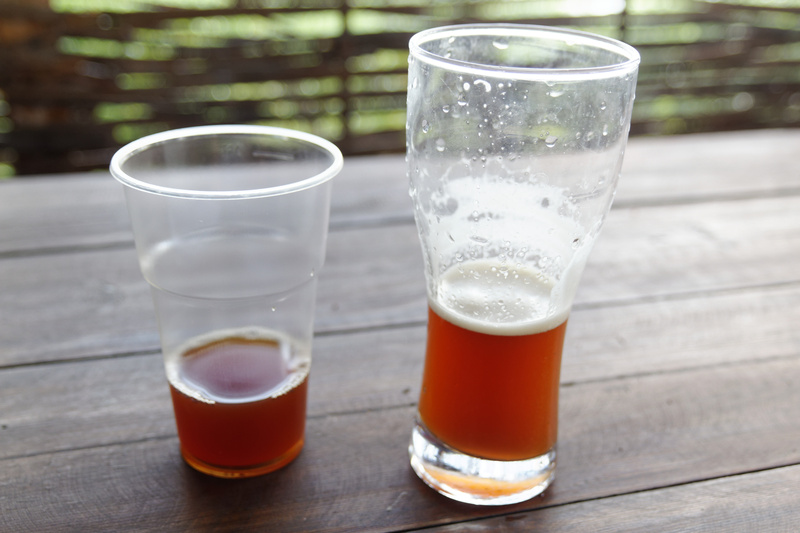
Dmitriy's beer (left: baker's yeast, right: ale yeast) |
He served us two versions of his own beer: one fermented with modern ale yeast (1 month old), and one fermented with the French baker's yeast (2 months old). Both beers were brown and hazy, and the one with ale yeast had a big offwhite head, while the one with baking yeast had no head. The ale yeast beer was good, but not really that special. The one with baking yeast was much better. It was sweetish, and had an earthy, fruity flavour with woody notes and I could clearly taste the rye. The woody flavour was a bit like juniper, although there was no juniper in the beer.
I couldn't taste the hops at all, but what really gave the beer character was a backbone of astringency that ran through the entire flavour from start to finish, lingering a good while after all the other flavours were gone. This, together with the fruity rye flavour, really made for a very nice and highly drinkable beer.
But where did the astringency come from? My guess is that it comes from the very long mash in the oven, but I can't prove that.
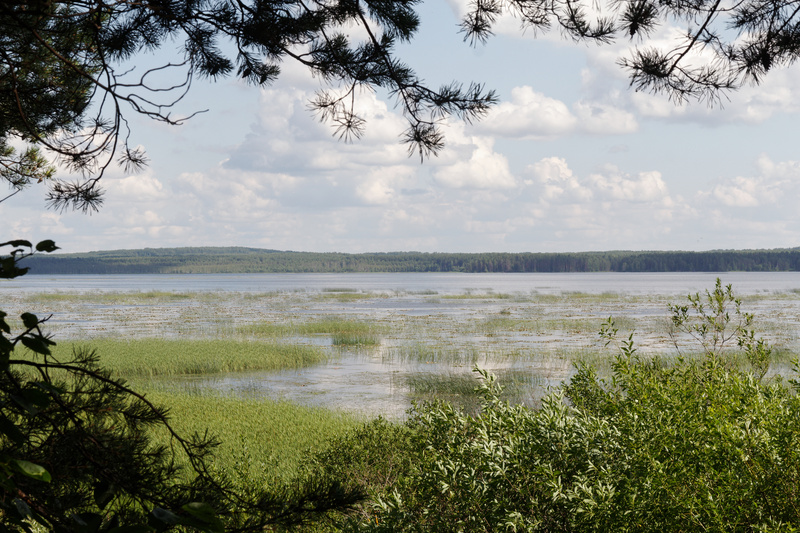
The lake view from the pavilion |
Sasha and I sat back with our beers, unwinding in the warm summer afternoon from the stress of the drive to and from Kudymkar the day before, and the night train. I tried quizzing Dmitriy more on the local brewing, but it was difficult, because he was constantly on the move. Lighting mosquito smokers to keep the mosquitoes away. Doing odd stuff in the dacha. Moving the mosquito smokers to adjust for the breeze shifting. Barbecuing fish and vegetables for dinner. Burning plastic bottles in the fireplace in a desperate attempt to keep the mosquitoes away. And so on.
After dinner we went to the banya, stripped off our clothes, put on felt hats, and relaxed in the heat to the point where our bodies started feeling like jelly. Dmitriy brought out the traditional birch twigs, and I got the whipping and massage with birch twigs. I'd always thought this whipping was an odd thing to do, but although Dmitriy was really whipping as hard as he could there was no pain at all. Being whipped was basically just another form of massage, something to get the blood circulation going.
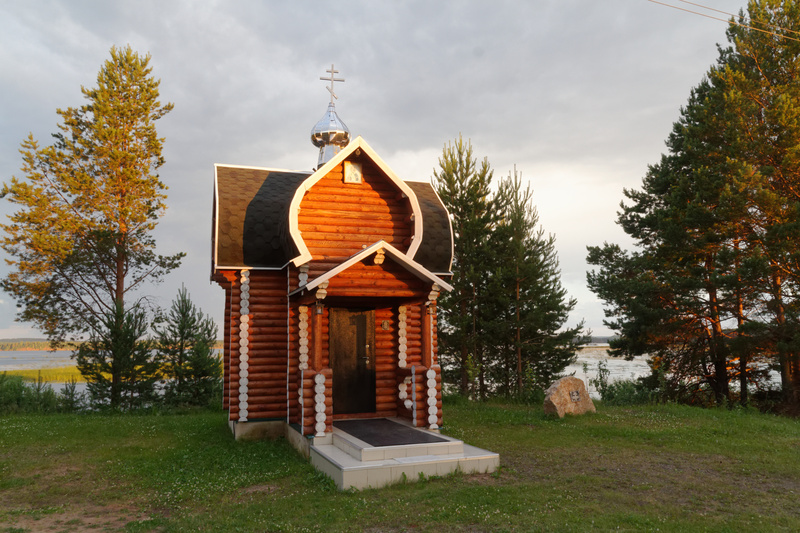
A tiny chapel by the lake, not far from the pavilion |
After the banya we went back to the pavilion and had some more beers while donating more blood to the local mosquitoes. Eventually the relaxation and alcohol was too much for Sasha and me, and all three of us went to sleep while the korchaga was still in the oven.
We spent more than 24 hours at the dacha, and I kept plying Dmitriy with questions about malting and brewing from my questionnaire, but I never managed to get through all the questions since Dmitriy never sat still for more than 2-3 minutes at a time. While we were packing to leave I looked him in the eye and told him sternly that before we left he would have to sit still for a while so I could ask him the rest of the questions.

The entrance to the dacha |
Eventually everything was stuffed in the car and the dacha shut down, so Dmitriy came and sat down on the steps. Looking like a scolded schoolboy he said "I'm ready to answer questions now." So I went through my list, learning that in the old days women were the brewers, the daily drink was kvass, not beer, and so on.
My final question was whether people ever used any plants other than hops in the beer. "Yes," Dmitriy said. "Some people used juniper." I looked up from my notebook in surprise, to see Dmitriy smiling. He'd clearly expected a reaction to that. Juniper has been extremely widely used in farmhouse ale, but even so it was a surprise to hear of people using it this far east. Dmitriy's answer expanded the area of documented juniper usage 1000km eastwards at a single stroke.
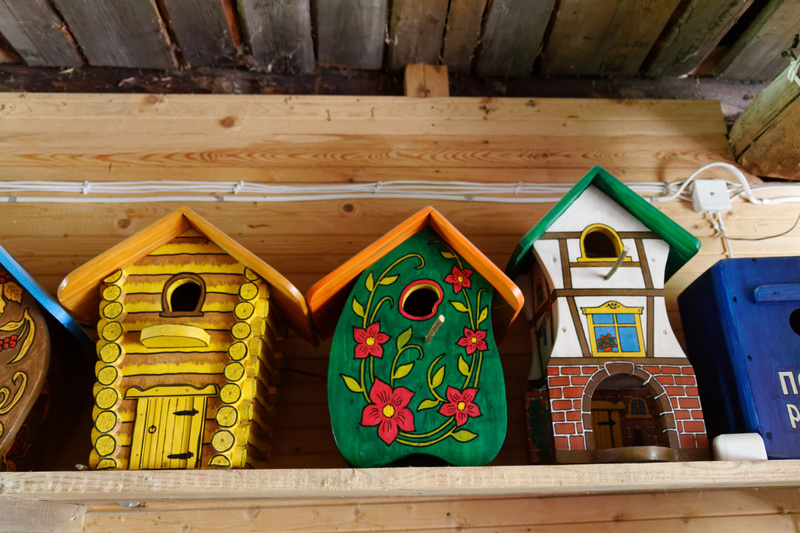
One of Dmitriy's hobby projects: birdhouses |
After I left Dmitriy went back to Vsekhsvyatskoye and asked the brewers there about the juniper usage. They put the tips of young juniper branches, sometimes with berries, in the boiling wort toward the end of boiling, they told him. The purpose was to make the beer bitter and give it juniper aroma.
And with that final surprise it was time to leave Shitovo and head back to Kirov for a meeting of the Vyatskiy Beer Club before Sasha and I took the bus to Chuvashia next morning.

An old monastery in nearby Slobodskoy |
Recipe
Ingredients for 10 liters of beer:
- 2-3kg of wet home-made rye malts
- Some handfuls of wild Russian hops
- Baking yeast
- Rye straw
- Two slices of bread
- One small stone
Cover the bottom of the korchaga with rye straw so that the opening is well covered. Add the malts, then fill up the korchaga with water. Probably about 10 liters of water are added. Heat the great oven to 150-180C, then insert the korchaga and wait 15 hours. The temperature in the oven should fall slowly over this time, and it's not clear if the contents ever boil. Probably not. Temperature 63C and pH 5.66 at the end.
Run off the wort from the korchaga, sparging with a couple of liters of boiled water. Boil the wort with some handfuls of hops for about an hour. (If you want, add juniper twigs toward the end.) Filter out the hops, then cool to 37C. Pour your yeast starter on the bread slices and wrap them in a bag together with the stone and one handful of hops. Then pitch the bag. Ferment 7-10 days, but remove the bag after 48 hours.
In general, with this beer I find it very hard to separate out the various factors and say why the beer tastes like it does. With Russian rye, home-malted, undried, oven-mashed, etc, there are basically too many unknown variables for me to separate them out and say what contributes what. So for now I'm just leaving this recipe here as is. Right now, all we know is Dmitriy brews this way, and this is what the result tastes like.
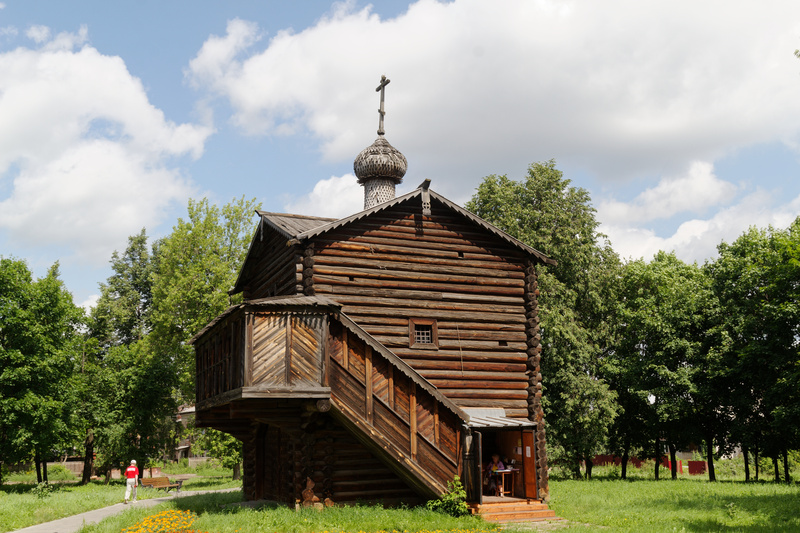
Old wooden church in Slobodskoy |
Similar posts
Brewing in Chuvashia
Suddenly, the bus drove out of the forest, onto a bridge spanning an enormous river, deep blue in the sunshine, and so wide it looked more like a lake
Read | 2019-02-03 11:26
Does bread yeast exist?
The title makes it sound like I've lost my mind, because of course bread yeast exists
Read | 2020-05-04 16:15
Comments
Alex - 2018-11-08 16:58:54
"I was about to ask why it didn't work out as expected when Dmitriy ran off to do something else. I managed to corner him later, and learned that usually he brews with all wet malts, but this time he used 50% dry and 50% wet malts, and that might be the reason. But he wasn't sure. "
By letting the malt growing longer the content of sugers is reduced by the plant I guess.
Very nice report! Reminds me a bit on finnish sahti, with the Juniper and the adstringent taste, but without the oven, usually stones.
Cheers!
Nick Cole - 2018-11-08 20:36:45
Great write-up as always! Dmitriy did not remove culm from malt before grinding, is that correct?
Aaron - 2018-11-08 23:04:19
This is great! I need to relearn so many things modern home Brewing has taught me. Like the fact that rye malt shouldn't self convert. So cool! I'm going to try this
Oli Woods - 2018-11-09 07:17:54
Just great, I love the yeast pitching temperature / baby bath water comparison.
Lars Marius - 2018-11-09 07:45:26
@Alex: It could be because it sprouted more, but that shouldn't cause the fast runoff. And Dmitriy has made his own malts many, many times. I bet he knows whether he sprouted too long or not.
The connection with sahti is because both are farmhouse ales, basically. Stones are quite rare in sahti, although there are people who still brew that way. The 2018 expedition was to Finland, so more about sahti later.
@Nick: That is correct. I'm still collecting data on this, but it seems farmhouse brewers quite often did not remove it. Some say it gave the beer a bad flavour, others say it did no harm at all. Whether this is related to differences between different landraces or what the issue really is I don't know yet.
@Aaron & Oli: Thank you.
Ed - 2018-11-09 13:19:48
I find rye malt coves an astringent flavour.
Lars Marius - 2018-11-09 13:22:21
@Ed: Coves?
Jeff Alworth - 2018-11-10 17:35:56
Wonderful, wonderful, wonderful. So glad you’re doing this work.
Flo - 2018-11-11 12:16:06
As a fan of russian culture AND beer, this blog is awesome! Please keep it up.
Bogdan - 2018-11-12 04:03:27
@Alex 'By letting the malt growing longer the content of sugers is reduced by the plant I guess. ' This is the correct answer. Sugars are the source of energy for the plant in the initial grow.
Alec H - 2018-11-12 22:37:01
I saw a reference to yeast being added on a bread in the Swedish Institutet för sprĺk and folkminnens beer culture collection and thought about this article. http://www.sprakochfolkminnen.se/matkult/kartan.html#/record/mk-kb494
There's also references to other fun stuff like people making a dough out of rye flour and water just like some of your Russian oven brewers. Also people loaning their neighbours yeast and making yeast cakes.
Lars Marius - 2018-11-14 07:52:13
@Bogdan: Letting the grain sprout for longer will of course consume sugar, but is 1-2 days enough to lose half the sugar? Seems unlikely.
@Alec: That's an interesting find. And thank you *so* much for that link! This must be from the ULMA archive. I didn't know some of their data was on the web. Will add this to my database.
Baking dough out of rye flour and water sounds like the Finnish mämmi, a kind of sweet dessert pudding, more than Russian beer brewing. Unless it's afterwards used in the beer. Yes, yeast cakes was a common Swedish practice. I've been planning a blog post on that.
Johann Renner - 2018-11-15 19:45:30
Hi Lars! Another amazing brewing story, once again! I can't thank you enough for all the work and information you've shared.
Regarding the astringency of the beer. If I understand correctly, the one fermented with baker's yeast is the more astringent, right? I've found that some brewer's yeast produce some level of astringency in beer (Lallemand Nottingham for instance), so maybe that flavor was developed during fermentation, not mashing. Just an idea.
Phil - 2018-11-15 21:46:32
I love reading about your encounters with different farmhouse beers and brewers, and this one really struck a chord with me for some reason - the process you describe is so unlike what we now think of as brewing, and yet so 'domestic' and straightforward... A message from another world, and yet the world next door.
Ed - 2018-12-29 04:45:41
Late to the party, but a couple things I didn't see in the previous comments that might be decent speculation.
It looked like that since he milled his grains wet, that he didn't remove any of the sprouts which presumably made it in. Sprouts can have a bitter flavor, which might be what you were tasting.
The other thing is the yeast starter. It could be people were originally using bread or a kept line of sourdough starter as a yeast source for their beers (and bread obv), especially if they were originally making kvass. Easier to keep one line of yeast for both bread and beer/kvass going, especially since the constant bread will keep it alive until beer is being brewed.
So add some of the sourdough mother in a bowl, rub in some leftover stale bread you kept aside from the kvass to give the starter a food source, some hops because you empirically know it keeps the beer from going sour and helps it keep longer, and the stone to weigh it down (or possibly for increased/stable starter temperature if a hot stone?).
Eventually sourdough was lost or too much trouble and someone started using commercial yeast, and keeping the same, now unnecessary, method.
Lars Marius - 2018-12-29 12:17:10
@Johan: You understood correctly. Yes, could be. It's impossible to tell without trying it.
@Ed: Yes, it's possible the sprouts added bitterness. In Stjřrdal they remove the sprouts, but historically there were many areas where they did not. Which could be because they wanted the bitterness, or because their grain didn't add any. Very hard to say.
It's very unusual to use sourdough in beer. Offhand I can't recall any examples of that at all. The normal was to use beer yeast in the bread, although many places people also had sourdough in addition. The kvass culture would be separate (that's a long story).
Hot stones were sometimes used to heat the wort if it got too cold, yes. But I wouldn't put hot stones in my yeast starter...
There's lots of different ways they might come up with this technique, but I agree it's probably hard to work out exactly what it was now that they use lab yeast. Maybe more accounts will surface from Russia one day and we'll find the answer that way.
András Borbíró - 2019-01-09 15:16:31
Hi Lars!
Very interesting read! I like your blog a lot, please keep going! :) It is so interesting to look at folk history through a given method or hobby, such as beer brewing.
András - A homebrewer from Hungary.
Rich Carbonara - 2019-01-22 17:02:43
Super interesting. I had some surprisingly interesting beers in Lithuania a few years ago. Thankfully, I ran across an interesting article about it, just prior to going. Will investigate your blog more in case I'm headed this way.
Henri Bau - 2019-07-21 09:32:32
Hi Lars, Thank you very much for your blog. It is unbelievable. I'm homebrewer in Brasil and all of those techniques are very amazing. Best Regards from Brazil.
B. Kline - 2020-02-05 01:45:30
Wow, this is absolutely fascinating. Just read this as I was doing some history research on beer in various European countries and got to Russia. I love it.
I love reading and learning about the various different ways different cultures have of making and creating beer.
I also run a beer blog, if you ever wanna check it out or write for us or have us write for you, just contact me on the blog:
https://thebeerthrillers.home.blog/
Prost!
-B. Kline
schnitter - 2020-03-03 07:42:11
Южно-вепсский диалект Сидорово | Soäjärv Веселов Николай Тимофеевич, 55 лет Запись 1964 года Страницы 218 - 220
Kut oлuden ḱẽṫiba | Как пиво варили
«Замачивают рожь. Раньше замачивали в озере в мешках, а теперь замачивают россыпью в бочке. Мусор снимают оттуда. Суток двое замачивают, затем снимают и рассыпают на пол. Она прорастает, появляются ростки, а затем растирают руками. Потом кладут в кучу на печку, зажимают камнями, либо чем-нибудь, чтобы засолодилось там. Потом снимают и сушат на печке. Затем на жернове смелют в муку, эту муку затем заваривают, кладут туда овса, овес прожаривают в печке докрасна. Овёс кладут, чтобы лучше протекал (солод), не так плотно садился в бочке, чтобы был более рыхлым. В бочку смешивают вперемежку овёс и рожь, варят в котлах с водой, делается опара. В эту бочку кладут горячих камней, чтобы опара выпарилась и засолодилась. Это делают дважды, в эту гущу камни кладут и снимают. Затем будет солод и сколько нужно, столько и кладут воды. Затем туда кладут кольца из ржаной соломы, чтобы протекала не опара через кольца, а протекало прозрачное сусло. Затем кольца кладут в опару, прижимают их камнями ко дну. Варят сильно эту опару. Затем устоится в бочке. Затем снимают и пропускают горячим, как только устоится. Протекает вниз под бочку в корыто, там сделан желобок и пробка. Из корыта черпают и снова кладут в бочку. Когда остынет, в бочку кладут хмель. Хмель растёт у нас в хмельнике. Хмель кладут сушёный. Побудет некоторое время – и заходит пиво. Потом покушают этого пива: когда доходит, когда не будет вкуса сусла. Вкус сусла перебьёт хмель. Получается пиво. Пиво кладут в бочки. Сусло едят, как молоко хлебают ложками и пьют, кто как желает. Сусло варят, кто сладкое, кто густое, кто жидкое. Садятся мужики в праздник вокруг стола, приносят чашку пива, пьют чашками. Подают с краю, кто сколько хочет, тот столько и пьёт, так вокруг стола и идёт. Кончится всё в чашке – снова приносят чашку, опять подают. Так раньше пили пиво. В Прокушеве мужики говорили: два ведра нужно носить в животе, иначе не стоит и на праздник идти».
Что ж, отбросим трудности перевода и подведём небольшие итоги.
• Для разведения дрожжей в Вепсском крае в начале 60-ых прошлого столетия существовали свои закваски. • Дрожжи разводили на ржаном солоде с прибавлением хмеля. • Хмель культивировали. В деревнях были свои хмельники. • В Вепсском крае существовало как корчажное, так и пожигное пивоварение. • Вепсское пиво – это прежде всего ржаное пиво. В некоторых случаях для лучшей фильтрации затора использовали не перемолотый, но хорошо высушенный в печи овёс. • Затор традиционно фильтровали через ржаную солому, а в Войлахте - также через еловые веники. • Во время кипячения сусла хмель не использовали, хмель добавляли на брожение и созревание. • На вторичное брожение добавляли также сахар. • Невыброженное сусло также употребляли в пищу – либо пили, либо ели ложками. • На праздниках чаши с пивом ритуально пускали по кругу.
South Vepsian dialect
Sidorovo | Soäjärv
Nikolay Timofeevich Veselov, 55 years old
Recording of 1964
Page 218 - 220
Kut oludenibaiba / how beer was Brewed
"Soaking rye. Previously, they were soaked in bags in the lake, but now they are soaked in bulk in a barrel. Garbage is removed from there. Two days are soaked, then removed and scattered on the floor. It sprouts, sprouts appear, and then rubbed with your hands. Then they put it in a pile on the stove, clamped with stones, or something to make it salty there. Then remove and dry on the stove. Then the millstone is ground into flour, this flour is then brewed, oats are put there, oats are fried in the oven red-hot. Oats are put to flow better (malt), not so tightly sat in the barrel, so that it is more loose. In a barrel mixed alternately oats and rye, boiled in pots with water, made sourdough. In this barrel, put hot stones, so that the sourdough evaporated and salted. This is done twice, and stones are placed in this thicket and removed. Then there will be malt and as much water as needed.
Then they put rings of rye straw there, so that the sourdough does not flow through the rings,but a transparent wort flows. Then the rings are placed in the brew, pressed with stones to the bottom. Cook strongly this brew. Then it will settle in a barrel. Then remove and pass hot as soon as settled. Flows down under the barrel into the trough, there is a groove and a cork. From the trough of the scoop again and put in a barrel. When it cools down, put the hops in the barrel. Hops grow in our hops garden. Hops put dried. After a while, the beer comes in. Then they eat this beer: when it comes, when there is no taste of the wort. The taste of the wort will kill the hops. It turns out beer. Beer is put in barrels. Wort is eaten as milk is slurped with spoons and drunk as one wishes. Wort is cooked, who is sweet, who is thick, who is liquid.
Well, let's put aside the translation difficulties and sum up the small results.
• For breeding yeast in the Veps region in the early 60s of the last century, there were their own ferments.
* Yeast was bred on rye malt with the addition of hops.
* Hops were cultivated. In the villages had its own hop garden.
• In the Vepsian region existed as carcagno and poignee brewing.
• Veps beer is first and foremost a rye beer. In some cases, for better
filtration of the mash, oats not ground but well dried in the oven were used.
• Traditionally, the mash was filtered through a rye straw, and in Volante also using spruce twigs.
• During the boiling of the wort, hops were not used, hops were added for fermentation and maturation.
* Sugar was also added for secondary fermentation.
* Unbroken wort was also eaten - either drunk or eaten with spoons.
* On holidays, cups of beer were ritually passed around.
http://www.beercult.ru/profiles/blogs/vepsanolut
Dmitry Ivanov - 2020-08-01 11:53:13
Стоит воспрининимать этот сюжет именно как сюжет об энтузиасте. Часть вещей и действий - это антураж, для зрителей.
Lars Marius Garshol - 2020-08-07 14:22:19
Dmitry: There's no need to be so skeptical. What Dmitriy showed us corresponds well with what other people report from the same region: http://bhdom.mya5.ru/nasledie/derevenskoe-pivo/
Renato Tapado - 2020-09-15 20:22:08
Hello! Where are the information about Serebyanka hops and its relation with Cascade hops? I didn't find it anywhere in internet. Thank you.
***) - 2021-01-11 07:02:42
Dennis - 2024-04-10 19:17:43
Well, just by scrolling it all down, that was the most advanced dude to brew. Not sure that "a green malt" technology is so innovative, though :)
Gavin - 2025-01-06 18:45:08
Hello
I am putting together information on edible plants and have been told that there is a Russian recipe for beer made from Couch grass (Scutch grass).
Below is the information I have been given, but it is not clear enough for me to try to make this beer. If anyone reading this has any information on the full recipe for making this beer:
12L spring water 1kg (2lb) Scutch Grass roots (washed well and finely sliced)
1. Soak the root pieces overnight in the water 2. Boil until the root pieces sink to the bottom of the pot (this prolonged boiling breaks down the leathery membrane of the roots and creates a light syrup)
This mash is then *sparged by pouring into a tub with a tap, and with its bottom lined with straw which is weighed down with stones. Hops and yeast are added. It is bottled with residual sugar for the secondary fermentation process in the bottles.